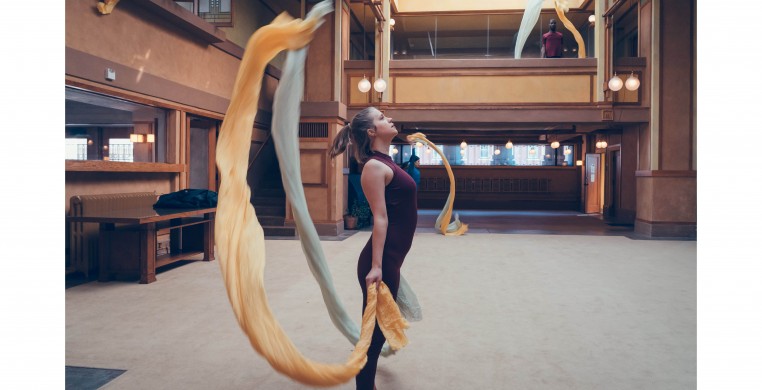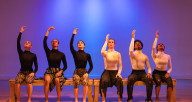On an average day, the historic Unity Temple provides Unitarian Universalists with a geometrically compelling place of worship. On February 26th, however, Unity Temple played host to Oak Park’s own Winifred Haun and Dancers for their latest project, “The Light Returns.”
Haun is no stranger to playfully engaging with space, nor is she a stranger to Unity Temple; her company performed the premiere of “Light in Winter” in the sacred space back in February 2020. This time around, however, the audience became part of the performance. Akin to the company’s October 2020 Cheney Mansion performance, “Steps in the Garden,” a guided tour of three centralized spaces within Unity Temple—the Entranceway, Unity House, and the Sanctuary—allowed for the audience to engage with the work on an interactive level.
Haun’s Unity House premier of “Flailing” incorporated light yellow and teal silk scarves, paying homage to Oak Park’s own Doris Humphrey, who used the same space to teach her “fall and recovery” centered technique in the early twentieth century. Standing under one of the balconies, I had a clear shot of duo Vernon Gooden and Crystal Gurrola dancing above me in the mirror balcony across the room. Warm, natural light-filled the space as the sage green paint on the walls glowed and reflected the setting sun. Yet as I began to lose myself in their technically impressive extensions, silks from the balcony above me blocked my immediate view.
In the Entranceway, Banks Performance Project—the dance company in residence at the Hamilton Park Cultural Center—performed Elysia C. Banks’ premiere of “Point A to Point B.” Choreographed with the space and set in mind, dancer Elijah Guardiola devoured the diminutive room. The intentional, contemporary movement was distinct and decidedly different from Haun’s traditional modern dance-inspired movement. The use of a high-backed, Wright-influenced chair and Guardiola’s soft voice repeating the phrase “it’s fine” brought up feelings of haunt and pain.
The premiere of “It’s Not About That,” nestled in a first-tier balcony of the Sanctuary, reincorporated the silks and Humphrey-esque movement from “Flailing.” Dancers Quint Lattimore and Summer Smith were exacting and slow-moving as they crawled across the pews and climbed up the geometrically patterned walls. I was distracted by the music filling the surprisingly acoustic room, and as I let my eyes wander, I found the Chicago Modern Orchestra Project couched beneath an adjacent balcony.
By breaking the audience into three separate groups, Haun offered every spectator a personalized show. We had the autonomy to decide where we stood within the space, as well as where we focused our attention. The power of choice, however, was at times overwhelming. Audience members were consistently reminded we would not be able to see all performance elements based on where we were standing in the room, yet there was something going in every direction to mitigate missing a moment of movement.
After a brief intermission, the whole of the audience centered in the Sanctuary. With balconies filled, keeping social distancing in mind, we watched as artificial lights filled the space—a direct juxtaposition to the natural light I’d become accustomed to. The Young Dancers Project performed a short piece entitled “Do You Wanna Play,” and though it was unclear how they fit into the program, it was impossible not to smile at the young performers' joyful energy and pride. An abrupt transition made way for a reprise of 2020’s “Light In Winter,” making it apparent Haun is a master of repetitive movement. Silks, lines, lifts, and spatial patterns were all recognizable based on the two Winifred Haun and Dancer premiers that came prior.
In the one-night-only performance, Haun blended her ever-familiar, linearly driven choreography with the famed prairie-style architectural elements of Wright. Her incorporation of curved lines and tossed silks paid recognizable tribute to the lilting styles of Doris Humphrey, yet the extended arabesque lines and flawless lateral executions were in direct tribute to the techniques of fellow founding mothers of modern dance. “The Light Returns” was an ode to what came before, made all the more special by its ode to Oak Park.


